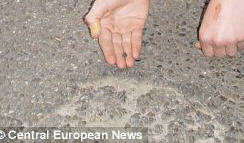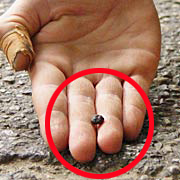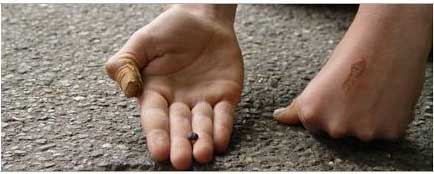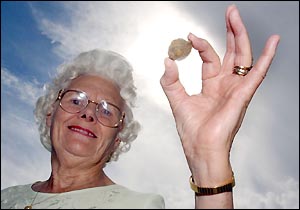Meteorwrongs and the Press
"Teenager hit by 30,000 mph meteorite" reports the headlines. 'Copy and paste journalism' has been exemplified by the waves of news outlets repeating aspects of Essen Germany's young Gerrit Blank's dramatic claim of barely escaping death from a fiery space bullet. The medias are eager to reprint this story but strangely unable to question its validity. The question carefully avoided: Is the account factual? Very few sources attempted to answer that question. Why?
According to media account, on June 5 at 9:35 AM, fourteen year old Gerrit claims to have seen a "cone of light", felt the blazing meteor strike (or come near) his hand leaving a 3 inch burn. He claims he was knocked off his feet by the thunderous sound which left his ears ringing. He then saw the foot long 'crater' in the solid surfaced road left by the still burning meteorite. Gerrit asserts that after being knocked down, he poured iced tea over the pea-sized 'meteorite' resting in its 'newly made crater' so he could take it to school.
 |
The 'meteorite', 'crater', and burned backhand |
Few medias/sites have attempted to research this extraordinary claim. Instead of contacting a meteorite expert, Derwesten (who broke the orginal story) followed up with an interview with the director of Walter Hohmann Observatory in Essen Germany. Ansgar Korte, who did not actually examine the stone, is quoted:"If it's really a true meteorite, then the specimen will have a certain value for collectors and mineralogists"1. Korte also suggested where the item may be tested. Unfortuneately, the other medias suspiciously misquoted Korte stating: "It's a real meteorite, therefore it is very valuable to collectors and scientists." Copycat headlines misreported that "Chemical tests on the rock have now proved it is from outer space".
MSNBC.COM attempted to correct the misquote stating: "later reports suggested that Korte's comments were mistranslated..." and more importantly, MSNBC interviewed a meteorite expert:
|
Another web site taking issue with young Blank's account is Popsci.com. Reviewing the mathematics involved, Adam Weiner concludes: "Will it have a velocity sufficient to induce enough compressional heating to produce a "flash of light"? Not likely. Could it create an impact crater a foot in diameter? No, it couldn't. Busted!"
Darryl Pitt (in the comments sect.) added: "A smoldering crater? As a result of cooling during an extended free fall to Earth, tiny meteorites are not even warm to the touch.2 |
Phil Plait's Bad Astronomy also contradicts reports that this was a confirmed meteorite: "My friend the Dutch science writer Govert Schilling talked to Korte who is claiming he never saw the alleged meteorite and was misquoted." However, Mr. Plait appears a little confused over the whole account. He discounts the 30,000 mph down to 124.3 mph (200 kph), but strangely fails to see the folly of a resulting foot long crater at that speed. Nor does he acknowledge the existence of the photo so perhaps he did not see the filled-pot-hole that young Blank claimed to be the 'crater'.
Marco Langbroek, geologist/meteorite/meteor expert, said:" I am 99% sure this story is a hoax. Too much things don’t ad up. For one thing, given the size of the small object, the “crater” is much too large. Second, the whole “red hot glowing & burning his hand” part is wrong... a meteorite this small is quickly slowed down by air friction and will *never* land with considerable speed. The breakup-proces you describe takes place at 15-25 km altitude or more! By the time this tiny piece has come down, it is clearly subsonic in speed. The whole description confirms to the Hollywood movie image of a “meteorite impact”, not to what really happens at the impact of such a small meteorite. To me, this suggests it was all made up."
  |
'meteorite' and 'crater' edge and burned hand |
media photos |
Was this a hoax? When will the results of the tests on the stone be published? When will the public know the truth? According to the medias' track record, answers to these questions will not be reported. Just look at Siobhan Cowton and Pauline Aguss. Both innocently thought they were hit by meteorites and that is what was reported. There was no follow-up, no correction, even though the 'meteorites' turned out to be earthly rocks. Why no follow-up? The truth is not as interesting and it makes the Press look somewhat foolish for printing the story in the first place. Don't expect any follow-up from the media especially in the case of a hoax or misidentification.5
 |
 |
Siobhan Cowton/meteorwrong |
Pauline Aguss/meteorwrong |
media photo |
media photo |
1
- Thanks to Martin Altmann for the translation
2 - see Myth#2
3 - Cold Meteorites
4 - Bold type added
5 - For more examples see In the News
SEE: Rock comes out of the Blue |
SEE: Not meteorite; thrown rock! |
SEE: Fourth-grader finds meteorite in yard |
SEE: Boy Sees Meteorite Land In Backyard |
SEE: Burnin' Desire |
SEE: Meteorites Don't Pop Corn |